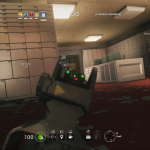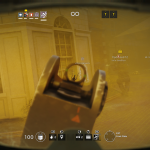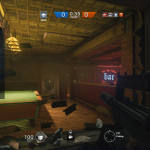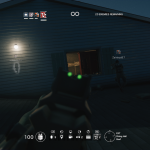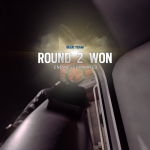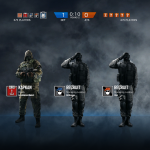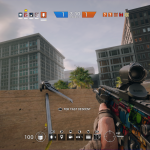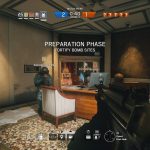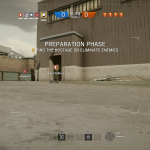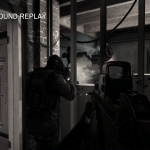
Tom Clancy’s Rainbow Six is a franchise that has been around since 1998 and has taken a lot of different forms. The first iterations where very hardcore tactical shooters which required the player to develop and execute their own highly technical assault plans. The next major form took the franchise to a more traditional linear format with a tactical edge with Rainbow Six 3. Then they refined this concept with a really innovative third-person cover system in 2006 with Rainbow Six: Vegas. In retrospect, the largest issue that has plagued the franchise is not due to the rapid change in format but with the lackluster follow-ups. Rainbow Six 3 was fantastic, Lockdown was a step back. Rainbow Six: Vegas was another great experience, but its sequel wasn’t that special. Ubisoft Montreal plans to change that formula with Rainbow Six: Siege. It’s the next main iteration of this once-popular franchise and the studio developing it has worked on an impressive array of highly regarded franchises. Can this developer bring Rainbow Six back to its former glory?
Tom Clancy’s Rainbow Six Siege is the next game in the Rainbow Six franchise from Ubisoft after taking a seven year absence. This title made a big splash when it was first announced and rightfully so, it was a bold and unexpected vision. The idea behind this game is asymmetric multiplayer where one team defends a building and another team assaults it. Each team has unique characters with unique abilities that all bring something special to the table. While this sounds quite simple, the ace up the sleeve for this title is its destructibility. And this isn’t superficial destructibility that was found in recent Battlefield games or Red Faction games last generation. This is a more refined, sophisticated destructibility. Whereas Battlefield or Red Faction will take out entire walls or entire buildings, in Siege you can poke a tiny hole in a wall and kill someone. You can blast a door or window open. This is paired with enhanced maneuverability like repelling up and down the building, makes for some highly dynamic and incredibly magic moments.
This game is divided into two modes. The first is this asymmetric competitive mode talked about above and the other is the classic cooperative Terrorist Hunt. When you start the competitive multiplayer, it starts out quite similarly to Dota with a character selection screen. Each character offers unique weapons, gadgets, and abilities that can turn the game in your favor and the characters are different for those assaulting and defending. The teams are five versus five and you battle across 11 different maps with a variety of different situations. The situations that can be encountered are hostage rescue, bomb defusal, and straight out kill everyone. The locations of the hostage and bombs are randomized through the map and have to be found during the match. This is achieved through a cool mechanic. While the terrorists are preparing for the assault by setting traps and barricades, the counter-terrorists drive little drones around the map trying to find their location and the location of the objective. This gives both sides something to do during the brief preparation phase. Once this is over, it’s time to start the real game. The defenders can choose to camp or go on the offensive but the game will warn you that if you go outside, you will be detected. The assaulters can tackle the building however they want. They can repel to the top and work their way to the basement. They can cause detractions. They can go straight for the objective and blow through almost all the walls. The variety of ways to tackle the situation are numerous and unpredictable. If the defenders choose to camp, the wait can be quite scary. You’ll hear muffled explosions through the walls. You’ll hear the counter-terrorists try to be sneaky by knocking out a wood panel to snoop in on a room. It’s a fantastic dynamic. After the objective is complete or one of the sides completely wiped out, the sides are flipped, new characters are selected, and it repeats to the best of five matches. The designers of this mode should be commended in not only how well it plays but how fast and quick can go. Matches go really quickly and while you’re out of the game if you die, the next match is only a couple minutes away. Overall, this is obviously the marquee mode of this game. As you rank up, you’ll earn access to custom and ranked game types. This will hopefully nullify slightly the biggest issue with the game, quitters.
The next mode is Terrorist Hunt. This is a cooperative mode for teams up to five players to tackle similar situations to that in the competitive mode but against the computer. There will be times you play the assaulters and other times as the defenders. The big difference in this mode is that the computer is not limited to just five players and it will spawn even more depending on the situation. For example, if you take out all the enemies and grab the hostage, the computer will spawn a new wave of enemies outside to stop you from getting to the extraction point. The mode has three difficulties and a couple different enemy types to keep you on your toes. Overall, it’s a fun mode but there are some drawbacks. First, if you die early, you’ll be sitting out of the game for a while. Second, some people may find spawning new enemies to be cheap in the middle of the action.
When playing these modes the game will occasionally come together in one perfect amalgamation but it takes a while to get there. For example, when you first start playing, expect a learning curve. The game does offer tutorial videos and a single player mode called Situations but you’ll do most of your learning on-the-job online. The maps are complex and will take time to learn as well as where the objectives typically spawn. Some of the controls are not adequately conveyed, like how to lean or how to use certain gadgets. Some of these are due to the nature of the game but others could’ve been better done. Next, the online has some issues. Far too many times, in a middle of the match, you’ll be kicked out for losing connection. If you’re in a peer-to-peer game and that game concludes and the person acting as the server leaves, you’re kicked back to the main menu. There are times the game doesn’t adequately tell you it’s still trying to connect you to another team. Most of the time, the game does a fantastic job, near instantly getting you into a game but other times it seems to hang and take a while when backing out and retrying is quicker. The next issue that will frustrate a lot of players is that there is sometimes a large disconnect between the action you experienced and what the kill cam shows. This is something that still plagues some games today but not to the extent you’ll see here. The next thing that doesn’t particularly impact gameplay is the game is set up like a free-to-play game. There is nothing that will give you a competitive advantage but spending money will help you unlock things quicker and access skins for you guns. It just goes to heighten the feeling that while the game is great, it’s not a full-priced experience. In summation, while the game does a lot of things correct, there is still a ways to go to making it feel like a complete polished experience. Some of these things will be corrected by patches in the coming days and months but others feel like they are here to stay.
With Rainbow Six Siege, the franchise is definitely back on track. The gameplay is incredibly tactical and fun. The destructible walls adds a new dimension to the competitive multiplayer. The speed and the flow of the competitive matches are amazing for something this type of game. It really feels like the game is on the brink of being something incredibly special. There is a lot of content coming out for free over the next year which should help the value proposition. Patches can solve a lot of the online quirks. The game is a bit rough but its foundation is solid and the gameplay is a blast. Tactical gamers should rejoice, Rainbow Six is back.
When you first boot up Rainbow Six Siege, the graphics are not going to blow you away. They are not that special. The colors are a bit washed out and the levels can be a bit repetitive due to them mostly being simple buildings. The in-game user interface has a lot of aliasing, especially on gadget icons and gun reticles. While it does run at a slightly lower resolution of the Xbox One, it’s not an issue that many other games have. On the upside, the levels offer both day and night variants which will help the game feeling fresh longer. The marquee graphical and gameplay feature boils down to the impressive destructibility. It’s a sophisticated, precision destructibility that hasn’t really been seen at this scale before. You can bring down windows and walls or you can shoot out a tiny hole and surprise unsuspecting visitors on the other side. This does bring up a couple issues though. Enemies can be a little hard to differentiate sometimes from the rooms. Guns take up a large amount of screen space which hinder your visibility. The worst offender is that sometimes your character will partially clip through the wall. For a game so dependent of camping, it’s disappointing to die because the enemy saw you sticking out the other side of the wall. Overall, the graphics won’t visually wow you but the destructibility serves the game amazingly well.
The sound design on the other hand, is quite good. This is no better felt than on the side of the defenders. As the opposing team assaults the building, you’ll hear them slowly get closer and closer until they finally engage. Everything is appropriately muffled the more they are away. It can be quite scary and tense as you wait for them to come. The sound will also allow you to spatially find out which direction they are coming from and how they are doing it. If they are walking on a floorboard, you’ll hear it creak. If they are repelling on the side of the building, you’ll hear their rigging clank. So much of the sound design is based upon the subtlety of these sounds and then when the action explodes, everything sounds great. It’s not all perfect as the music is quite forgettable but it just keeps the menus from being too quiet. Plus, while I really enjoyed the music from the original titles, it obviously has no place in a multiplayer title. The audio dialogue can be a little confusing as whenever a teammate’s drone finds an objective, it will say that you found the objective, leading you to turn around thinking you in fact found something when you didn’t. Overall, you won’t be disappointed with the sound design here. The dynamic of the hunter and the hunted is very real here and it’s amazing.
Rainbow Six has gone through a lot of iterations through its lifetime. From the first title and it’s in-depth strategy to the more action-focused variants of Rainbow Six 3 and Vegas. Wherever this franchise has gone it has left some fans behind but also gained a lot of new ones. Rainbow Six Siege is no different. While everyone is still chasing the Call of Duty crowd and speeding gameplay up with new maneuverability options, Siege is slowing things down. While other franchises are scaling up, Siege is scaling down. In today’s market, Rainbow Six Siege is unique. It’s tactics-first approach and asymmetric multiplayer is a breath of fresh air. Did they succeed completely in this vision? No. It’s still a bit rough around the edges. But they did enough to earn a fan and with a lot of free content promised down the line, it feels like the developers are committed to this title and its value proposition will only increase with time. Rainbow Six is back after a seven year hiatus and while there is still some more work to be done, the foundation has been set. If you’re a fan of tactical combat, with patience and friends, this game should not be overlooked in the slightest. There is simply nothing else like it on the market.
Gameplay
Graphics
Sound
Overall

